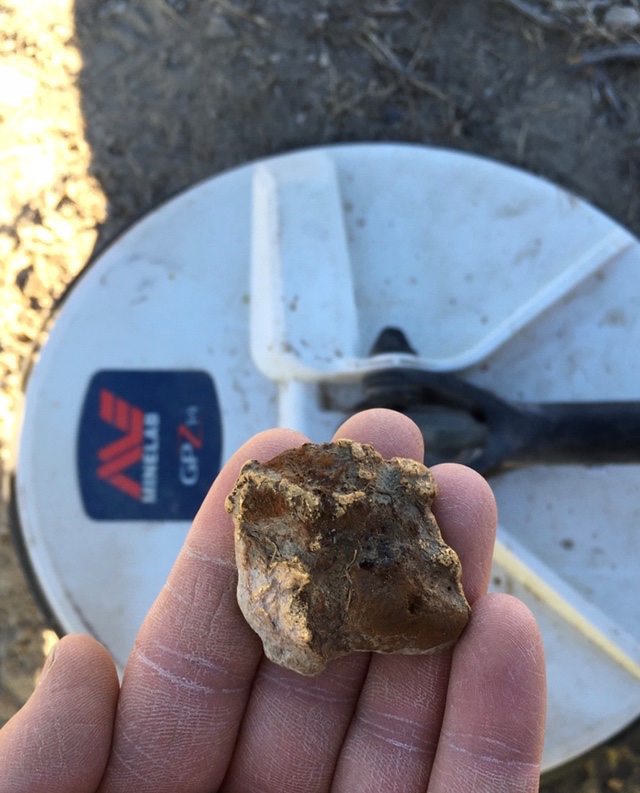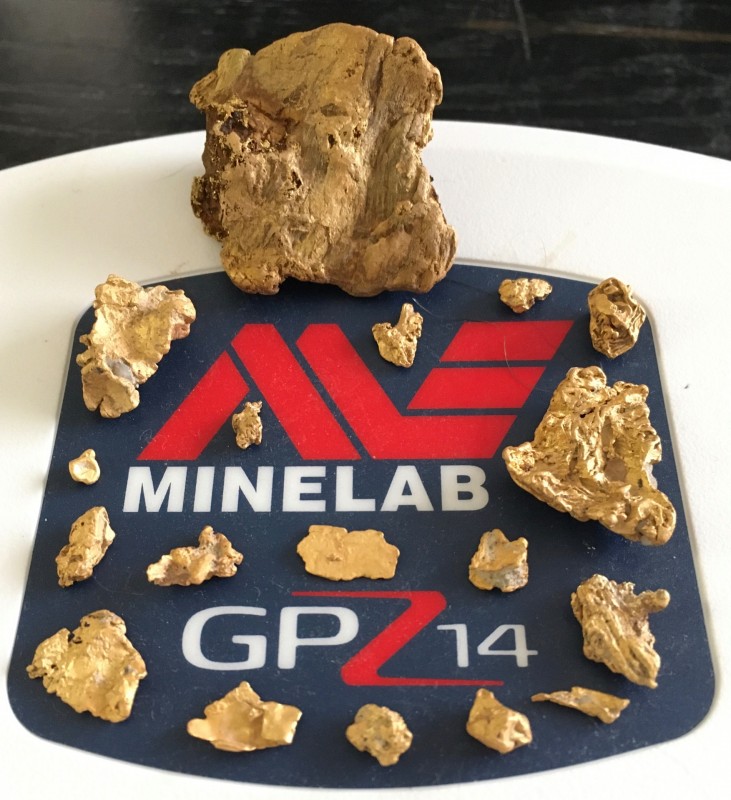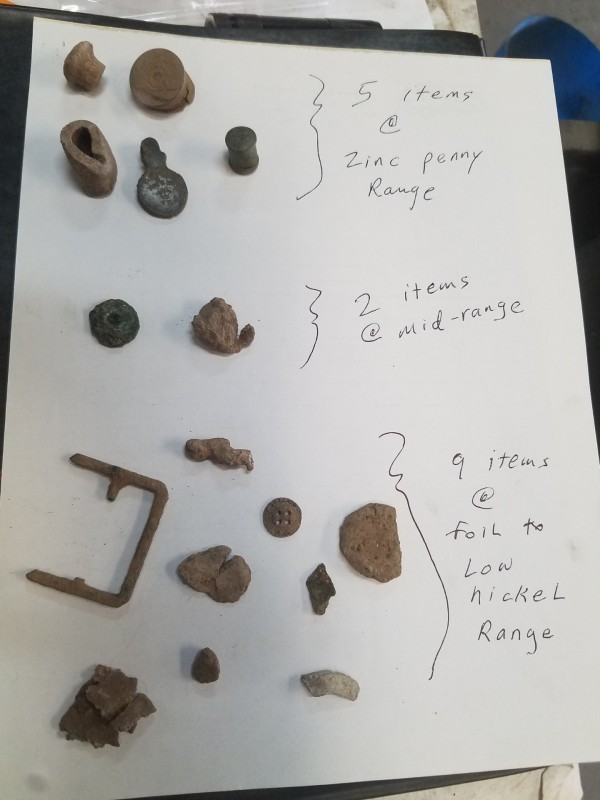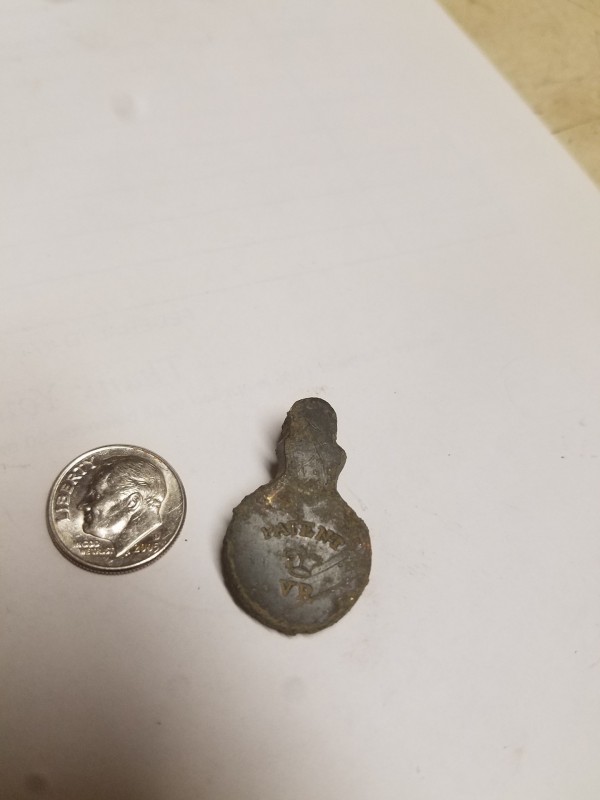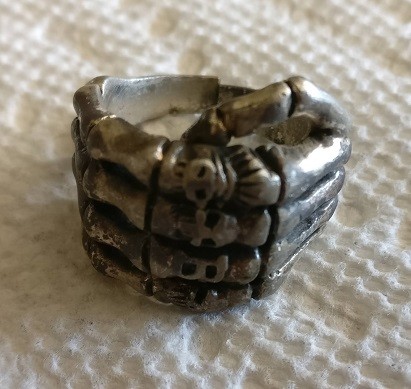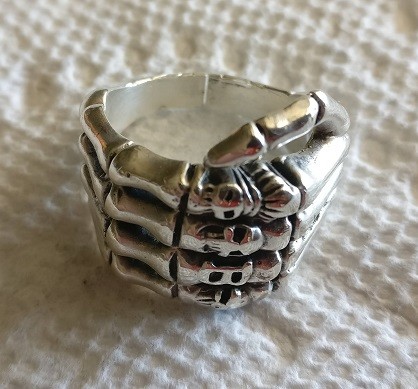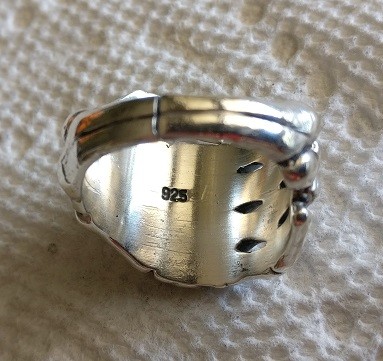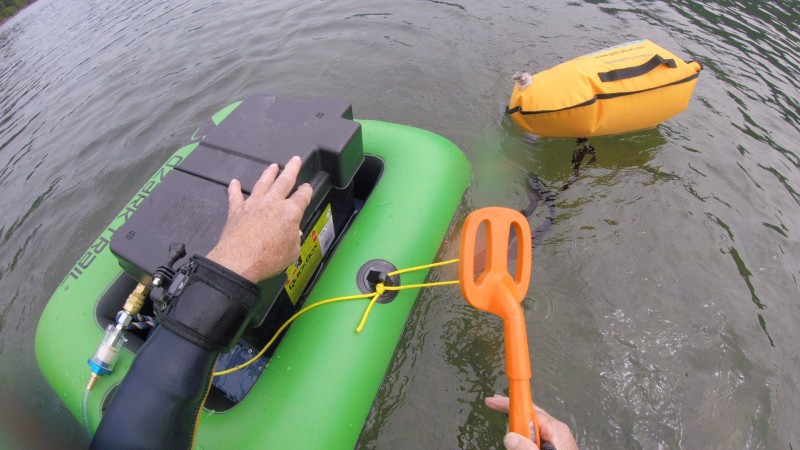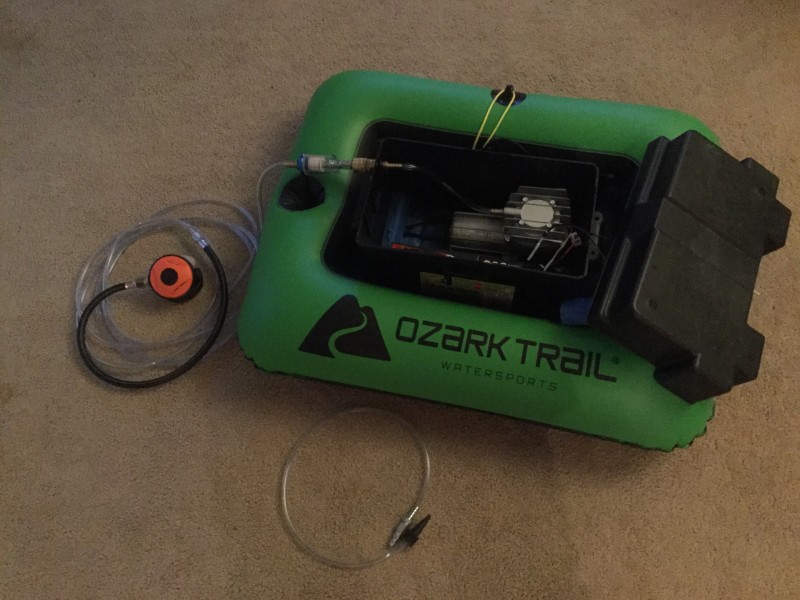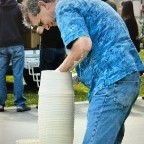Leaderboard
Popular Content
Showing content with the highest reputation on 11/13/2020 in all areas
-
With the fantastic weather in the Rye Patch region during the month of October, I was chomping at the bit to get down there, but my summer job didn't end until the 30th. It still took me a few days afterward to get everything wrapped up, so I finally hit the road and met up with Gerry and friends at Rye Patch the following Tuesday. The detector training class we were scheduled to give that weekend ended up being cancelled, thanks to a winter storm that was forecast to move into the area on Friday. Needless to say, having only two days of optimal detecting conditions before being snowed out and forced to move on to Arizona was a total bummer.😞 Intent on finding a few bits of gold in-spite of the looming storm system and armed with our trusty Minelab GPZ 7000 gold detectors (and one SDC 2300 - also quite trusty, btw), we hit an old patch in hopes of digging up some previously overlooked yellow metal. Only two small nuggets were found after a couple of hours searching with four coils on the ground - not a very good start. It was then that I remembered another old patch nearby that I had completely forgotten about, it had been so long since I had been there. It wasn't a very good producer back in the day, but perhaps we would be able to find a few nuggets that the VLF and early PI machines may have left behind. Within minutes of hitting the ground, my good friend Chef Rusty and I both popped a shallow sub-gram nugget; not a bad start. Soon, everyone was digging good gold! My second target gave an obvious yet deep sounding signal response from the GPZ's stock 14” coil. I imagined it to be a three or four gram piece at a depth of 12” to 18”. Gerry noticed me digging quite an excavation and came over to capture the action on video. At a measured depth of 20”, the target was finally out of the hole, and as I held it aloft there was an audible gasp from the audience that had gathered to watch, followed by cheers and fist-bumps: After a thorough cleaning, the specimen weighed in at a whopping 40 grams - a totally unexpected and pleasant surprise! The nuggets kept biting sporadically for everyone the rest of the day, and the same was repeated the following day. Just goes to show that sometimes the ZVT tech can really ignite an old burned-out nugget patch. Much fun was had by all, and it really made up for such a short two-day detecting trip. Pictured below are my finds, including the 40 gram chunk, a couple nuggets at over 8 grams, and all the small bits, with a total combined weight of over 66 grams.5 points
-
Yes guys, to avoid any confusion, all the nuggets pictured so far in this post were found by yours truly.🙂5 points
-
I'm back to Boise now and getting detectors in customers hands. Thanks for everyone's input on this dandy collector piece. I have yet to do an AZ gold show so if possible, I might try the one this winter down there (if Covid doesn't ruin it). I may not have dug as big of gold as LUNK did right in front of me, but at least I found a collector piece. Thanks again everyone.4 points
-
In all the years that i have been detecting i have never ever used anything to clean or preserve any of my finds this includes many many roman,saxon and celtic gold and silver coins and many artefacts going back 1000s of years.All i ever do is use a very very soft old toothbrush under running water from the tap and dry them off. Over the years i have seen many coins including some rare ones rendered zero value because folks have used chemicals,abrasives,tumbled them and other ways as well,coin collectors who are looking for rare valuable coins basically prefer them as you found them other wise they wont buy them if cleaned the wrong way. The only things that i may possibly treat would be BA 'Bronze Age' items like axe heads or spears as often they can suffer from a bronze disease that can start eating away at the bronze,but although i would look at getting these items treated i would not do it myself though. Of course what i do with my finds other folks may not do,but i prefer to be on the safe side and not damage some historical items because of lack of proper cleaning knowledge,my motto is 'if in doubt dont'.4 points
-
There is a little coin shop next town over from me that used to be a Whites dealer and now has a big Garrett Sign out front. Will stop in and see what they have for inventory. Seems Garrett is using some of the original Whites dealers for distribution. Nice to see the dealers still offer equipment and not disbanding local sales. Good to be able to see new units in hand rather than just online pictures and videos.3 points
-
XP deus has an adjustable iron volume ,, and XP Orx does not have an adjustable iron volume, but the iron volume is quite well set ... In both signal detectors you can turn off the iron volume, so in some cases you can ..clear the signal ... These detectors belong to the class of the best separation detectors in iron, Tom_in_CA ......... I wonder if you ever used Etrac with 13 "ultimate ...in long tone... to detect this place ...3 points
-
2 points
-
Valen's Legacy's oil is an extreme example of rancid oil! I think he said it was about 150 years old! Any oil can go rancid! About the only thing i know of that does not go bad, is honey! Archeologist's have found honey over 2000 years old that was still edible! Now i don't know if anyone has ever tried to preserve coins in it, but who know's!! I would imagine any preservatives would have to be PH neutral, and exclude oxygen! Sounds like some fun experiments could be done with some non-valuable dug or damaged coins! And some small mason jars! Just like canning food!👍👍2 points
-
Hey guys, I'm gonna geek out on this debriefing report 🙂 A couple of friends were down in my area of CA @ early November to do some beach hunting. At the conclusion of their stay, one was kind enough to loan me his Deus for a few weeks. Which I will ship back to him when done. Over the years I've heard how this is supposed to be the "cat's meow" in nail/iron-riddled sites. But never had my hands on one personally. I've always just reached for my Tesoro Bandito in such situations. Which, as you know, is wimpy on depth, has no TID, etc. Then a fellow I know gave me an hour's tutorial over the phone from Virginia a few days ago. Walked me through all the settings, pros/cons, etc.... Last night I was able to take it on a maiden test voyage to a certain adobe site. An "adobe site" in CA, is our version of what the east coast guys would probably call a "cellar hole" site. This site was the adobe home of a Mexican land grant recipient. Granted in the early 1830s. Although the dude might already have homesteaded the place earlier. This is just his formal grant date. And since this was on the road between 2 mission era towns, it was a stopping spot in those days. Ie.: hospitality to travelers, did trading, etc.... Today is nothing but a faint rectangle outline of adobe melt in a hilly cow pasture area. After the gold rush and statehood, this was one of a myriad of the 800-ish land grants in CA, that just got taken over by the incoming settlers. Either via bought out, or legal maneuvers , etc.... And apparently by the 1860s, was abandoned. The *newest* coin we ever found there, was an 1860s IH. When we first researched it in about 1995, it was SO thick with targets, that we literally went into park mindset. Eg.: going high disc, avoiding iron-ridden patches, and not bothering to dig anything that didn't ring the bells of Notre Dame. Just so many targets to choose from. I filled a box with 10 or 20 lbs with green copper, endless cool doohickeys (mankiller balls, gun parts, endless henry shells, lantern parts, buttons, etc....). All told we've pulled about 20 to 25 period coins from here. Many reales, many early seateds, etc.... And perhaps 15 phoenix buttons. By the early 2000s, all the "easy gimmees" were picked off. Leaving only the thicker iron zones to get more stuff. Because go figure, when we started in 1995-ish, it was machines like XLT, 6000 Di pro, Whites Eagle, and Fisher CZ6. None of which are known for ability in heavy iron. Then eventually using creative arsenals to see through the iron, we got to where even the iron zone was getting stingy. So today, the site is nothing more than a test zone. For testing machines for their iron-see-through ability. Such that .... even if you only got some more camp lead or copper snippets you KNOW that your machine or method you're testing is competitive. Ie.: a sport-unto-itself JUST to eek some more conductors from there (even if they're not turning out to be coins ). Thus this was the perfect test site for the Deus . Started with the "basic" (#1) pre-set program, and modified from there. Assume the basic pre-sets, unless listed here : 1) Disc : negative 1 2) Full tones 3) sens : 90 4) Frequency : 17.6 5) Iron volume : 1 6) Reactivity : 4 7) Target volume 5 8) Audio overload : 0 9) GB (ground balance): 85 10) contrast : 10 The results were astounding : 16 conductive targets. See the pix. And as you can see, several of them *could* have been coins. I especially like the lock-dust cover. That was deep ! Of course , since I'm just learning, I got fooled by cast-iron. There is a different sound, but nagging doubts sent me to dig a few "just to be sure". More than I would have been fooled by the explorer, yet more conductive targets that the Explorer would have found last night. And the ratio actually wasn't that punishing. Like if I got 16 conductors, I don't think I got more than 5 or 6 iron . And for several of those conductors, there was utterly no doubt. So theoretically I could have been more picky, and dug zero iron. But it's a trade off , since some targets could be fighting masking. Hope y'all enjoyed the report. Looks like I'll be looking to buy one of these, as soon as this loaner period is over 🙂2 points
-
The Orx is a simplified version of the Deus , less settings , 4 programs instead of 11. However their results in the field are almost the same because they use the same coils , and for the XPs wireless most of the electronics "job" is done inside the coil . The only difference I can see the Orx multitone is limited to 3 tones , no "fulltones" available ... But this is not a pb, when in an "interesting" area you dig everything which sounds good ...2 points
-
I bought an ORX with the 9" HF coil. I liked it so well that I then bought the Deus. I feel the ORX will find every target the Deus will find in iron, both using the same coil. The Deus offers many audio features that make it the better all around detector. Iron sites - ORX or Deus. Parks, Schools, etc. the Deus gets my vote. The ORX has two coin/relic programs (Deus fast and Deus Deep) along with two nugget hunting programs (can be used for coins & relics also) and two slots for user custom programs. Only three tones in fast or deep programs, no five, full, or pitch options. But the ORX does have wireless headphones and wireless connection to the Mi6 Pinpointer like the Deus. Now that I have the Deus, and seeing how I only use it in the iron infested sites, I could be perfectly happy with just having the ORX for that task.2 points
-
2 points
-
That sums it up nicely. We don't need 'curse' in the title. We don't need exaggerations as the narrator does repeatedly, much to my annoyance. We don't need pirates or Knights Templar or Francis Bacon or William Shakespeare. Except, if we want to watch, we actually do. Because they can't justify the small audience that would result from leaving out all the sensationalism. So those of us gullible enough to not have figured it out after watching a couple shows, who aren't so cynical that we think it's all fiction to make oodles of $ for the 'actors', TV networks, and corporate sponsors -- we come back for more. Sometimes it's disappointment and annoyance, but often enough there are tantalizing pieces of the puzzle to tickle our curiosity. For some of us, anyway.2 points
-
Here's the way i look at Oak Island, and all the other related "reality" shows out there! I can seperate the character's like Gary Drayton and Josh Gates, to name just a few; from what they are looking for and the places they visit! It's very obvious that something big went on at Oak Island, for a long period of time! Treasure or not, the history, and the things constructed there are a fascinating look back into the past! Anything beyond the history; meaning a treasure, is what keeps most of the "normal" people watching! And no, we are not "normal" ! Detectorists are a breed apart from the average "Joe"! (Pun intended)! Who else would go out on a beach in a storm, being battered by big waves, to find a few pieces of rusty metal, and maybe an occasional ring, or old coin or two! The same with water hunters; risking jellyfish, stingrays, and bull sharks, to find a few crusty rings and coins! Or the desert guys, stepping around rattlesnakes, and scorpions, in 100 plus heat, to find a few tiny nuggets! We are all "crazy" for history! Weather we know it, or not! If we find some kind of treasure, all the better! But most of the time, the "real treasure" is the people, places, and experiences that are shared by "abnormal" people like us! Anyway, didn't mean to wax poetic there! But i think you get my point! The various show's still feed our addiction, just in a different way than the everyday viewer! That's why we are especially critical of the "characters" seemingly random decisions, and actions! But what we would normally do, would probably bore the hell out of the average viewer, and never come close to fitting into an hour long format! And there lies the rub between "reality", and "entertainment" !👍👍2 points
-
As long as you don't use whale oil! 😂 VL found out the had way oil of whale is not the best idea, but mineral oil is what i use to store my largest iron meteorite in. I was advised by some experts and i have had no problems. The oxidation problem i was having with the iron meteorite has stopped though due to no oxygen.2 points
-
2 points
-
There is a wax that most people put on them after they do some small cleaning. I don't think the oil would be a good solution as it can go bad. I found some coins in an old jar and can tell you now that it smells so bad you don't want to be in the neighborhood since it has been opened. It has taken 6 different cleanings to lower the smell to a level that one can get near them. The cleaning rags do keep the animals away the yard as they hang on the back fence.2 points
-
Simon Simon Simon you must add a disclaimer when you put that on the WEB. My wife kept both eyes on me when two Jewish backpacker did a soap rubdown nude at an open air shower when we were Bushwalking one day. (yes the wife was there.) Back to detecting at one beach every time we were there a young local boy about 12 years would always turnup with in minutes of starting detecting. He would dig every target for me. I guess the fault was mine as I let him have all the modern coins with the exception of the golden $1 and $2 coins. By the way I think I got more value than doing it all myself (Did not waste time on junk and digging.) As for TV gold Shows I have given a wide berth after seeing one.1 point
-
Absolutely, muchacho! We"ll have to pile into the Chef"s side by side, get out off the beaten path and find a couple of new nugget patches while we're at it.1 point
-
Lunk, So glad we were able to do a couple days swinging Northern Nevada with the 7's before the storm blew in. That 1+ oz'er is sure a great way to start your season off and I am so glad to be there and witness the live dig. Amazing that old patch has never had a 7 out there and it just goes to show the newer technology will get you more gold. I know your season is about to start and so I look forward to reading more of your posts in DP. If I don't get into MX this winter for some swinging, I'll certainly fly down for a week or two just to thaw out (snowing in Boise right now) and dig a few AZ nuggets with the 7. We'll need Chef Rusty to keep us fueled, so make sure he is on board. Last time to Yuma was so funny as we drove the rental car .5 mile off paved road, pulled over at some dry wash piles and started beeping nuggets. I'm sure it won't be as easy this time so I think I'll drive the car a full mile before we pull over and start hunting. Good to see you again Amigo.1 point
-
Hey there El-nino: Of all the incarnations of the Explorer, the Etrac was one that I never availed myself of. So I can't answer that question 😞1 point
-
I first started as a Dealer in '77. I had a job in Law Enforcement, but my 'hobby' was metal detecting and I wanted to sell what I used because I felt that brand to be the best. For me, yes, and therefor for others as well. Through the years, until the end of 2013 when I got out of dealing, I was either a one-brand dealer, or a 'multi-line' of two or three brands. For ME, I sold either one or multiple brands, but what I was selling was also what I was using because I was an Avid Detectorist. Coin shops are usually operated by coin dealers and most of them do not, or have never, been really 'active' in the hobby. They don't used them or know them, they just carry a popular brand name and draw metal detecting hobbyists into their business who shop for detectors and maybe get them into selling some of the older and collectible coins they find. Or, maybe making some sales to them since they have an interest in older coins. It's no different than some stores only selling one brand of bicycles or baseball gear, or other products that carry just one or maybe two brands of some product, and also the sales people never use many of the products, and the business owner doesn't use a lot of it, either. It seemed like most of the time they didn't really know the product to try and 'sell' you on anything and simply referred to comments in the manufacturer's marketing literature. I can guarantee you that most smaller-size detector dealers were not making a living on detector sales alone. Often it was simply an occasional sale with very little profit. And, for the most part, we saw a lot of smaller dealers, either out of a business front or out of their home or trunk, back in the hey-day of the metal detecting 'craze' during the '70s and '80s that started dying off in the early-to-mid '90s. Today, and it depends upon the country or region we live in, the metal detector sales business is a far cry from what it used to be. Here in the USA we used to have a lot of metal detector dealers around. In '81 I lived in a smallish town of about 15,000 people. There was a White's Dealer at the paint and hardware store, a coin shop sold White's, and a guy also sold White's out of his home. There was a Fisher dealer who sold out of his home, and I was a Garrett Dealer and had a metal detecting shop, and I also set up at Outdoor or Sportsman's Shows. That was really getting into the high-times of the detecting industry which pretty much peaked from '83 to '86, at least here in the USA, and then sort of leveled off for a short while. At that point many detector makers started to close up, from about 1990 on, and by then mail-order (actually using the mail and based on ads in magazines) became popular and the big discounting started. It really got a boost in discounting in '87 and '88 and progressed from there. Then the internet started about '95 or so and it took no time at all before magazines died, local dealers started to close up, and we have had fewer and fewer local guys selling sicne so much is super-discount based. Bigger businesses could afford to be a multi-line outlet, but most local dealers or individual dealers kind of stuck with th one or maybe two brands they used an that was it. 'kac' is fortunate to still have a 'local' dealer around, whether or not they know much about the product because he can at least stop by and check out some products in-hand. Monte1 point
-
We had a blow over the weekend and I was there. A huge cut was formed at the beach. I had new personal bests in total rings (10 for a day), gold rings (5) and quarters (64). I took a break to eat during the evening so I have two 'sessions' at the same beach. It was good enough to return with my sore back. It was a target rich environment. The total for all change was $24.03 which is also a personal high for change. I have found $20 bills on the beach in the past. These are the rings by session. More after I went back and the tide went out a bit than the first go. The L ring was the first ring I found it is 14k/3.2g. The other ring is 1.3g/18k. The green ring is 1.9g/14k. The black ring is 5.5g/titanium Legend of Zelda ring. The crusty ring is 3.5g/.925. The yellow stone ring is 3.8g/18k. This is a little 'old' ring and a cheap 'love' ring. The ring on the left is 16.9g/18k but I question it. The ring on the right is silver and is the last ring I found. The reason I 'question' it is that it had some green corrosion on it you can see in the first picture and now when I go to clean it the pocks appear even with the gold color. Perhaps that means it is a high copper ring? I also think it is 'old' but some of the edges don't look like it has worn that much in the wet surf/sand where I found it. Comments are welcome. Mitchel1 point
-
Thanks Bill. I use an 800/15/23/F2=0 and dig everything ... well ... my back says skip a few pennies here and there when targets are plentiful and slow down to hear the deep 10s!1 point
-
1 point
-
1 point
-
I purchased a Deus in February, and I recently purchased a ORX. Performance seems to be equal to my Equinox,but what I really like the most is the light weight of the Deus and orx. I am 75 and the Deus has really made a difference in how long I can detect without my body hurting. I still have the Equinox, but the Deus is now my favorite.1 point
-
Rich, no snow here. However, at got down to 16° before sun-up, and now at 10: 30 AM is is mostly clear, sunny and warmed to 26° and a liht breeze picked up so I don't think I'm heading out today, snow or no snow. So, like every cold and confined winter it means indoor testing. The Garrett MS3 headphones are one of the most appreciated 'accessories' we could ask for (other than an accessory cil assortment) and I have a set for each of my Apex devices, plus the separate Tx/Rx package to use them with any of my other detectors and get away from corded headphones. As for a testing spot that is out of the weather, I need to get a couple of grandsons out here to handle a chore for me. I moved my old carport and we sided it with metal siding and Monte Jr. added a mad-door. That 12X20 structure is now my enclosed woodshed. But when they put the last batch of loose wood in there, they piled in on the center open area rather than stacked it around the side with the other wood. The central area is where i do some in-door (but chilly) out-of weather testing as I can bury targets in the dirt or just lay them on the ground and still have the detector deal with the ground mineral make-up. As for the Apex, no, it doesn't have some adjustments like recovery speed or iron bias or whatever else some folks bring up, .... however .... it does have very good in-the-field performance, handles a lot of iron debris quite well, considering the slightly bigger-size 6X11 DD coil, and so far, everything about the Apex I like. Performance, as well as quick-and-simple adjustments, available settings, and I definitely can't forget the wonderful light-weight and comfortable balance. Now, to get my hands on Garrett's new coils and a smaller size NEL coil, such as the 5" DD for the really challenging sites I like to hunt. That will help me pass some time awaiting weather improvements. Glad you're replacement Apex took care of the issues you had and I'm sure it is a detector that will hang around in your personal outfit. Monte1 point
-
Very nice! Sore back for sure haha. I did not see the detector or detectors used. From your gear list I narrowed it down to two ? Again nice spin !1 point
-
Fantastic finds. I'm in S .CA as well but was land locked all weekend. A friend hit big at a cut north and I saw there were cuts south as well. What machine were you hunting with?1 point
-
1 point
-
The archaeologists at the UK's Portable Antiquities Scheme specifically advise against using oils or waxes on finds. Here's a link to their guidance: https://finds.org.uk/documents/file/PAS_ConservationAdviceForFinders2018-all.pdf However, if you choose to coat a find in a wax, perhaps for aesthetic reasons, the safest option is Microcrystalline wax. This is sold under a variety of brands, one we have here in the UK is "Renaissance Wax" , but 'Dental modelling wax' is essentially the same product, and is cheaper and readily available. It has a pale pink colouring, but as you're using it in a very thin layer, this becomes irrelevant. https://en.wikipedia.org/wiki/Renaissance_Wax Another professional product that is sometimes used is an adhesive known as Paraloid P-72. When made as a weak solution ( 2% ) dissolved in acetone or similar solvent, it can be applied to finds. See here: https://zoicpalaeotech.co.uk/paraloid-b-72-in-fossil-preparation/1 point
-
I wasn't able to take advantage of the great beach conditions this past weekend but I hunted yesterday to see if there were any stragglers left behind. There weren't a whole lot of good targets but I did find about $1.50 in clad, 2 rings, 2 cheap chains and a fair amount a lightweight trash. One of the rings was stainless steel but the other was a hefty sterling silver ring of 14+ grams. Pretty sure that this ring had been there a while because of the tarnish and it was a little bent from tumbling in the rocks, I presume. http://metaldetectingforum.com/picture.php?albumid=832&pictureid=82490http://metaldetectingforum.com/picture.php?albumid=832&pictureid=82491 I would have loved to have found some gold but at least the silver is interesting and a sign that the gold could have still been within reach. Maybe next time! http://metaldetectingforum.com/images/smilies/yes.gif __________________1 point
-
1 point
-
Well Mitchel, congratulations, because you've definitely hit onto a well guarded secret to successful nugget hunting that was related to me by the late, great and legendary nugget shooter, Smokey Baird. I first read about it in an ancient magazine article, circa 1996, titled Dinosaur Gold, written by a reporter that interviewed Smokey en route to one of his Rye Patch area nugget patches. The reporter had asked Smokey how he thought the gold had been deposited there geologically. After first meeting Smokey, I asked him about the magazine article, and he replied that his response to the reporter's query had been heavily edited, and so he proceeded to tell me the real story, and it goes something like this: Once upon a time, the entire area was covered by a huge inland body of water named Lake Lahontan and prehistoric birds swam in the lake. Now if the diet of a bird and the soil conditions on the bottom of the lake were just right when that bird took a sh!t and it hit the lakebed, it would form a nugget. And, when a whole flock of these prehistoric birds were gathered together in a cove protected from the wind and a dinosaur suddenly came up over the ridge and scared the sh!t out of them all, that made a nugget patch. The funniest thing about this explanation is that it works just as well as any geologic theory about the deposition of gold in the area, so all you have to do the next time you're out patch hunting is to figure out where those coves are.1 point
-
I have built a couple of 12v hookahs, the latest is similar to the Blue nemo, It works fine for shallow diving to 15ft, I use a small 7.2ah battery that gives me an hour, I have 2 batteries in the group 24 battery case I use to contain the unit and change when needed, it works fine but if the Nemo had been available at the time I would have bought one. The photos show the hookah and the cooler float I use also the inflatable dry bag that holds wallet, keys, glasses etc.1 point
-
1 point
-
After my success at the beach the night before I was ready for another 'bite' of it. Conditions were almost the same with all new sand and targets minus a few I found the day before! haha Now that I knew targets should still be there again I went with the tide down as far as I could go until near the hard pack. As you can see it was another productive hunt. This time someone showed up and 'infringed' on my hunting style but I adapted. I still got 47 quarters, 55 dimes, 19 nickels and 28 pennies in addition to a couple of the most unique finds for me ever. I was on a slow grid to get everything that sounded with the 15" coil. To do that the coil speed has to be slower in order to get the 8" plus 10s to be loud enough to dig. This has been part of my learning curve with the 15 on the beach. At one time I thought of it as 'finicky' but now I know that was mostly my impatience and not the coil. Any way here are the finds. As you can tell it was another 'good' ring night as far as the count goes but most silver and only one gold. The silver rings total 8.5 grams. The gold items were a Jesus pendant at 4.4g/14k and the 1.3g/14k ring. Now for the 'unusual' stuff. Early in the session I had dug a deep mostly negative target. It was down 14-15 inches. It turned out to be the rust covered crescent wrench. Later on while working slow I got a little 10ish signal and it kept dropping through my scoop. When I looked at it I could hardly believe what I was looking at. A tiny crescent wrench! It is not a working wrench but who could believe I find a .84 gram wrench by itself. Another thing I found was a silver chain that weighs 6.3g. To top off the session I had gotten another '10-11' and it was dropping through my scoop also. When I finally got it in my hand I couldn't really believe what I was looking at. It was a gold nugget! How could I explain this? Was it a part of a jewelry piece? No, it wasn't solid and then it hit me. It was gold and it was from a tooth. It also had the hollow on one side. The waves had kicked out a 'nugget' that weighs .73g and I found it with the 15" coil. So those were two really odd finds with very similar ID. I attempted one more hunt on the beach but there was a squadron of detectorists on it. I consider this session to have given up 7 more rings for a total of 17 in two days. It is my best beach. Mitchel1 point
-
That caught my eyes and ears (he mentioned it on the preview last week), and gave me a sinking feeling. That was confirmed last night. In the last 5+ years I've watched about every treasure/prospecting show that regular cable carries. This one is my favorite, and the reason is because of Marty Lagina in particular. He's not one of those "stars in my eyes" kind of people (like his brother, who I really do like also). He's an Occams Razor skeptical type of person. The other thing about this show that sets it apart -- they use the most up-to-date scientific investigation methods, and include many knowledgeable and experienced investigators from universities, etc. And that's why I'm disappointed. I really couldn't care less if Gary Drayton falls for hocus pocus. I just wish Marty had less confidence in Gary. So what's my problem with the OKM exp 6000? Simple. I've looked through their literature and I can't find anything where it says how it works. They brag about all its (seemingly questionable, IMO) capabilities, features, bells and whistles. But anything about the science behind it? Not that I can find. If that (in conjunction with its pricetag) doesn't signal ones skeptical side, well, it should. I looked at Carl's page and can't find this one listed. Maybe he'll see this post and chime in. Ok, I'll post the link to their USA distributor (it's manufactured by a German company). I'll give you one guess and a hint -- a recent new member of this forum has the same name as this company. Read all about the OKM products here. Don't expect to get any straight answers on how they work, though.1 point
-
Huh ? What is "it" ? There's nothing there. Kind of reminds me of the show where they are traveling around the globe in search of various lake monster creatures. Kind of like the Loch Ness monster, yet the various lore from various lakes around the planet. They scuba and sonar and all sorts of expensive equipment to "find the monster" . They interview locals who relate the stories they heard as kids. They interview others who claim to have seen the creature, etc... In one scene, the scientist dudes are explaining this expensive sonar (or whatever ) equipment, and finish by saying : "If it's down there, we will find it ! It can not evade this detection equipment !". Next scenes they are scuba diving and exploring the lake bottom at length. Musing how the creature "must have gone into one of these holes/caves" (as they point to crevices and overhangs and hole-openings in the rock bottom). They surface, as the show ends, saying "some day we will crack this riddle and find the lake monster fish". To which I had to laugh, remembering that just 10 minutes earlier in the script, they'd been saying that their equipment would have all that's necessary to prove or disprove the myth. Huh ? 😵 Then wouldn't their lack-of-finding it prove that it's not there ? Huh ? WTF ?1 point
-
Ring-a-Ding-Ding!! 🤩 SoCal got the cuts this time for sure! Hardly any north of the Santa Barbara line that I have heard of!?!?1 point
-
It's called a 20 inch whisper Simon. Only a few people in the world can hear a little fart in a windstorm and Lunk has proven it time and time again.1 point
-
Lunk, the Z couldn’t do it without you, no doubt about it an amazing detector...operated by a more amazing detector’ist!1 point
-
A 10 ring day! Woo Hoo! Congrats on a terrific hunt. Nice to be there when the conditions are right.1 point
-
Last week I was looking at 14" of the white crap and below zero temps. This week snow all gone, sun shinning, and 60+ degrees so I headed out for more cleanup work on some gold. Anyways...had fun, got some sun, and outta the shack!!!! The big 6 had a whopping weight of .270g...!!! Big or small...I love em all.1 point
-
1 point
-
I wouldn't buy a metal detector yet. The first thing you should do is find out your rights. You could start a new thread in the main forum (https://www.detectorprospector.com/forums/forum/4-detector-prospector-forum/). Title it something like "seeking information on Canadian mining laws". Then ask your questions about mineral rights, ownership rights, etc. Assuming you have some rights to recover gold on your property, the next step is to find out what size gold has been mined there and in your area. Some locations have only tiny gold which will not be detectable. Size matters! I mentioned member Jim Hemmigway earlier. You could send him a private message via the little envelope icon on the very top of the detectorprospector site you are viewing right now. It's located at the far upper right corner. Just give him a brief overview like you have here and ask for his advice on proceding. Even if you have no mineral rights on your property there still are possibly areas not far from you that you can prospect and maybe even detect. You're on the right track asking questions. Persevere.1 point
-
Yes, the 'collector' market taps into people outside of the gold market and that becomes a multiple of what you have been offered so far I imagine. I went to a Tucson show and the display of tiny gold nuggets was impressive but they do know their craft of taking a stunner like yours and making it spectacular! https://www.goldrushnuggets.com/1grnegonu9.html https://www.naturalgoldtrader.com/1-p-86-Gram-Nevada-Chevron-Gold-Nugget.html https://www.worthpoint.com/worthopedia/rye-patch-nevada-crystalline-chevron-82654871 point
-
we all agree on choosing the right tool for the conditions ... however, I don't forget that one of AQ's main advertising arguments was some iron discrimination ability. it would seem after reading the owners' reports except maybe the jag, that it's just a deeper PI 🤔.1 point
-
White's MXT Engineering Guide David E. Johnson, engineering consultant This Engineering Guide is written to provide dealers and customers greater insight into what kind of product the MXT is, from an engineering perspective. It does not attempt to provide complete information on the features and use of the MXT: for that, please consult the MXT user's manual. A BIT OF HISTORY In January 1998, White's decided to develop a true multipurpose metal detector, with the kind of sensitivity it takes to be a real gold prospecting machine, and with computerized ground tracking for ease of use. White's in-house engineering staff was tied up on the project which eventually became the DFX. Therefore, in February White's asked me if I might be interested in taking on a new protect. I had a good track record on gold machines so it seemed like a good fit. I agreed. A month later at a dealer seminar in Sacramento, California, Jimmy Sierra announced the project, and said if the engineer didn't deliver, the engineer would have to go into hiding in Mexico. I was sitting in the back. We ran into one problem after another along the way. Jimmy, good chap that he is, didn't sic the thugs on me, though there were periods he was frustrated enough that the thought must have run through his mind. Although the project took longer than we expected we got two products out of it - the GMT and the MXT. The first major hurdle was to get the basic circuit and software system running, with a first class ground tracking system. The system architecture was totally new, not a revision of the existing Goldmasters. In early spring of 1999 an ugly prototype was up and swinging, and Larry Sallee became involved in field-testing. By April the ground tracking system was working so well that since that time very few changes have been needed. At that point we knew we had a solid foundation, so work began on the display, discrimination and target ID features. During the fall of 1999, we decided to tackle the problem of desert heat head-on. A lot of gold prospecting is done in desert heat in full sun. I set up a crude but effective, thermal engineering laboratory, measuring the temperatures reached inside housings of various configurations and colors in full sun. Then began the task of finding an LCD, which would handle the heat. Because the LCD display is an important feature of the MXT, we revisited the whole issue of display. The manufacturers of LCD display had expanded their product offerings. We found a larger one, and changed the mechanical design of the MXT to accommodate it. A FSTN 0160 F was selected, (there are more to choose from nowadays, so we used a bigger one than the GMT in the MXT.) In early 2000, White's decided to bring out a new Goldmaster based on the work that had already been done, while development of the multipurpose unit continued. So we modified a prototype to work with the Goldmaster search coil at about 50 kHz, and you know the rest of that story - the GMT "tracking Goldmaster" was introduced in early spring of 2001. As work continued on what eventually came to be called the "MXT", we spent a lot of time on the discrimination and target ID system. There are many different ways to do discrimination and ID, each with its own advantages and disadvantages, which aren't always known until you've had the thing in the field being tested for a while. A lot of work got thrown out as we found deficiencies in what had already been done, and discovered ways to improve things. As the project got closer to production, more people became involved with it, and offered their own ideas to improve it. The reason the MXT is as good as it is, is because of that long process of field-testing and revisions. While the MXT was still under development, the DFX was introduced. The MXT design was then revised to run at about 14 kHz in order to take advantage of the DFX loops. When it was finally time to call it "good" in June 2002, the MXT went into production quickly and smoothly. CIRCUIT DESIGN The circuitry of the MXT is almost identical to the GMT, which has already been on the market for a year and a half and has proven to be rock-solid. The GMT's circuitry broke a lot of new ground. It uses a reactive impedance transformation network to boost transmitter voltage for higher sensitivity. It uses an active transmitter regulator to keep transmitter voltage constant even when the search coil is moved over black sand that would blow an unregulated machine off the air. The differentiator-filter circuits usually found in metal detectors are eliminated. Those functions are now done in software, which is made possible by the use of a high-precision 16-bit A/D converter used in a way that makes it equivalent to 17 1/2 bits. All the controls are digitized, their function actually performed via software rather than in circuitry. The audio system is temperature compensated in software to eliminate threshold drift. For the MXT, we chose an operating frequency of 13.889 kHz. This is high enough to give good sensitivity to gold, low enough to give good target ID on typical coin, trash, and relic targets, electrically compatible with search coils derived from the DFX and halfway in between power line harmonics to minimize electrical interference. SOFTWARE The MXT uses a Microchip PIC 16C76 micro controller, chosen for its low power consumption and its set of features, which was a good match for this application. The software that runs in this chip is based on that in the GMT, but almost all of it is new or has major revisions, except the device drivers and the ground tracking system. Much of the new software is for target ID and discrimination, features that were not present in the GMT. Even the iron probability and VSAT systems in the MXT are new, despite their apparent similarity to the GMT. The MXT/GMT does as much of the signal processing as possible in software rather than in circuitry, using what we call "low-speed DSP architecture". The demodulated signals are digitized, and processed and analyzed in software. Control positions are also digitized and made part of the data in software. The desired audio signal is computed, and then converted back to voltage using a 12-bit D/A converter. The circuit board communicates with the LCD and trigger switch in the "pod" via a custom-designed serial link. In the MXT the filters, differentiators, and sample-and-hold functions are performed in software, not in circuitry. This eliminates the problems of channel mismatch and drift, which are often encountered in such circuits. The discrimination system is a second derivative ("two-filter'') design for quick response over a broad range of sweep speeds. The analysis system for determining what kind of target is present has special features which reduce interference from ground minerals, and which automatically scale target ID confidence according to the mineralization level. GROUND TRACKING SYSTEM The ground tracking system comprises two subsystems: a ground analysis engine, and a ground balancing system. The ground analysis engine continuously monitors incoming signals to determine whether the signals probably represent ground, or may be something else such as metal targets or electrical interference. Signals, which seem to be ground only, are put into a data analysis subsystem, which analyzes the data for a number of variables. Then it can be determined what the balance point of the ground matrix is and how fast that balance point is changing. It'd be nice to describe all this in detail but we'd rather not teach our competitors how to do it. The ground balance system does the actual balancing of the signals, doing in software somewhat the same job as a ground balance knob does on a manually balanced machine. When the TRAC toggle is in the "ground" or "salt" positions, the ground balancing system follows the output of the ground analysis engine. When the toggle is in the center "lock" position, the ground balance subsystem stops following the output of the ground analysis engine, which is still chugging away in the background continuing to gather ground data. The ground analysis engine can do a good job of telling the difference between ground matrix and anomalies such as hot rocks and metal targets. In order to tell the difference, it has to see matrix by itself during at least part of the sweep. When you're not in "lock", keep your sweeps broad, and don't loiter over the top of a target when checking it out. Otherwise the analysis engine may lose the ground matrix and start tracking into the target. However, if the target is strong enough to register on the VDI readout, the target ID system will tell the analysis engine to halt, allowing you to check the target without tracking into it. In all three programs, pulling the trigger to pinpoint a target also tells the ground analysis engine to halt. Some users will hunt with the tracking toggle in "lock", occasionally updating the ground balance by flipping into "ground" or "salt" momentarily when they start hearing too much ground noise. The resolution of the ground balancing system is 1 part in 4,000, and most of that resolution is concentrated in the range where high mineralization occurs. Therefore, the individual resolution steps are below audibility under all conditions. THE VSAT SYSTEM The VSAT system on the MXT is similar in a general way to the one on the GMT. The VSAT function is done entirely in software. Up to about 2/3 rotation, the SAT is of the conventional (first derivative or auto tune) kind, giving a "zip" sound on a nugget and a "boing" sound on a negative hot rock (cold rock). As you approach maximum rotation, the MXT goes into "HyperSAT". HyperSAT is a completely different type of SAT system with different sounds and target responses. The background threshold sound is a little rattier, but nuggets are crisper, the ground is quieter, and negative hot rocks vanish when you slow down your sweep. For all but the most experienced users whose ears are calibrated to hear every little nuance of a regular SAT signal, HyperSAT gives more effective depth in bad ground than normal SAT. THE DISCRIMINATION CONTROL The discrimination control does pretty much what you'd expect. Unlike some discriminators, when the control is at zero, there is no discrimination at all - i.e., "true zero discrimination" - and all targets will be detected. Below about 2, the discrimination is based on a combination of both signal phase, and signal strength relative to the strength of ground mineralization. This feature allows the user to get good rejection of shallow iron with minimal loss of deeper targets. THE GAIN CONTROL The gain control knob controls two things at once: the preamp circuit gain, and the software gain. The following is a simplified explanation which is not technically correct in all its details, but will serve to give a general picture how the gain control works. As you advance the gain control from 1 to 10, the preamp circuit gain steps through five levels of gain: xl, x2, x4, x8, and x16. On most machines (depending on minor variations in search coil alignment) you can hear a momentary blip as the machine switches from one gain level to the next. The recommended preset (marked by the triangle) corresponds to a preamp gain of x8. In mild ground conditions where there is no electrical interference, you may want to advance the gain control into the crosshatched region. In this region, the signal data in software is multiplied by successively larger numbers, increasing the loudness of the signals. It is somewhat similar to the "audio boost" function found on some other models of metal detectors. It's particularly useful if you're using the speaker rather than headphones and there's a lot of noise from traffic or wind, or if you're demoing the machine to someone else. BASIC SENSITIVITY PERFORMANCE Since this is a multiple-purpose machine, a U.S. Nickel coin is the most appropriate standard test target. With the gain cranked up, and in the absence of electrical interference, a nickel will typically "air test" beyond a foot using the standard 95O search coil. Your actual "air test" distance will depend on your hearing, the sweep speed, what search coil is used, how much electrical interference is present, and how you have the controls set. In comparison to other machines in this price range, the MXT is extremely hot on low-conductivity items. On gold, it's right in there with the more popular gold machines, being especially hot on the larger, deeper nuggets. It will compete with all comers on low-conductivity , relics and on nickels. On high conductivity coins such as quarters and silver dollars, it is still an excellent performing machine, but there are several other products in the same league for sensitivity. GROUND TRACKING PERFORMANCE The ground tracking system is nearly identical to that in the GMT, which is widely regarded as one of the best tracking systems on the market. Compared to most other trackers, the MXT has superior resolution, tracks faster, "jumps" into new ground more quickly, has greater resistance to tracking into targets, and tracks over a wider range of soil conditions. The MXT allows tracking to be inhibited if desired. DISCRIMINATION PERFORMANCE All discriminator designs are compromises. Here's how the discriminator in the MXT stacks up against other machines. AIR TEST "DEPTH": generally well beyond 10 inches, because of high sensitivity, with effective discrimination to within 0-3 inches of the basic air sensitivity of the target. Most discriminators will discriminate in air to within 0-3 inches of the target air depth on most targets, but most don't have the sensitivity of the MXT. QUICKNESS & TARGET SEPARATION: among the best, because of medium-speed second derivative ("two-filters") design. Initial field reports indicate that the MXT's mixed-mode tone system gives indication of adjacent ferrous/nonferrous targets, superior to that obtainable through discrimination. IRON REJECTION: Because of its high sensitivity and a slight preference in the software for not losing questionable targets, it'll be a little chattier than some less sensitive machines. Reducing sensitivity by cutting back on gain, or by reducing the threshold control setting to minimum, will help quiet it down when necessary. DEPTH IN MINERALIZED GROUND: Although the MXT is a two-filter system, it incorporates special techniques which reduce ground interference and which reduce the "chopping & popping" which plague most other two-filter machines. This, together with its high basic sensitivity, makes it an excellent machine from the standpoint of discrimination depth. FAST SWEEPING: Many discriminators tend to lose good target signals, even shallow ones, when quickly sweeping the search coil. The MXT is tolerant of moderate search coil sweeps, that is to say good at both faster and slower search coil paces. SUMMARIZING: The MXT has the responsiveness and sensitivity of a first-rate 2 filter machine, combined with the discrimination accuracy of a first-rate 4-filter machine. TARGET I.D., ETC. With its small medium and large blocks on the target ID screen, the ID system in the MXT bears a superficial resemblance to the "Signagraph" of the Spectrum XLT. It should be realized that the traditional White's Signagraph system is typically (optionally) set to accumulate data over multiple passes over a target, and displays the accumulated average. The MXT displays fresh data on each pass and scales the size of the block according to how strong the signal was relative to the ground conditions on that specific pass over the target. The visual ID system on the MXT is fast, easy to read, generally more accurate than the discriminator, and gives a visual indication (via block size) of how reliable the identification is. It is going to change the minds of many beeper enthusiasts who previously thought visual ID to be of little practical use outside typical coin shooting. CASCADE THE CASCADE OF EFFECTS OF GROUND BALANCE SETTING: In order to know what the ground balance setting is; flip momentarily to the gold program if you were in another mode. Electronic ferrite material and most "negative hot rocks" (cold rocks) will usually read in the 75-88 range. Most soils will read somewhat lower. Readings will almost never go below 25 except in salt or moist alkali soils. When readings indicate smaller numbers than 50 you may notice some reduction in sensitivity. Below 35, some rusty iron may give unpredictable responses. Below 25, iron objects may give unpredictable responses and/or may disappear entirely and the sound on nonferrous objects may become slightly more abrupt. MANY THANKS To Kenneth White and Alan Holcombe for having sufficient confidence in me to put food on my table through the good times and the rough times on this project. To Jimmy Sierra for having the patience to argue with me about all the stuff that needed arguing about, for being so passionate about the need for this product, and for being willing to compromise when that's what it took to keep the project moving. To Larry and Sue Sallee, for their personal hospitality and for field testing prototypes. To Keith Zorger, Randy Smith, Mike Brighty who field-tested and helped develop the MXT. To Bob Canaday, for being such a competent technical/engineering liaison, doing a lot of not glorious but necessary work well and managing the project during its sometimes difficult phases. To Rick Maulding, for overseeing the project, for technical contributions to the discriminator and to the salt system, and for committing White's engineering department's finest minds to engineering review during the "slow SAT isn't hot enough" crisis, which led to a major system revision that made the whole machine better. To John Earle and Dan Geyer, for diligently hacking away at problems until they became non-problems. To Steve Howard and Pam Godell of White's. There were other people involved in this project whose contact was primarily or exclusively with White's and not with me. The risk of printing credits is that one may inadvertently omit a name that belongs there; so, if I missed someone whose name belongs on this list, I'm sorry, it was an unintentional oversight. - D.E.J. P/N 621-0468 published 8/2002 by White's Electronics1 point



.thumb.jpg.95344db3aeef0a4c6c73420daa366191.jpg)

